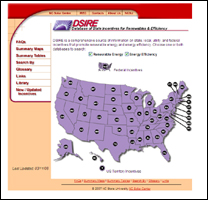Wind Policy
Federal, state, and local policies play an important role in wind energy development. More than 20 states have established renewable portfolio standards that require electricity providers to obtain a portion of their power from renewable sources. More than 15 states have established renewable energy funds that provide financial incentives and other types of support for wind energy development. In addition, voluntary consumer decisions to purchase green power can provide an important revenue stream to support investment in wind energy facilities. And finally, wind can play a role in helping states meet their air quality goals.
Wind Energy and Air Emission Reduction Benefits: A Primer

This report provides a user-friendly summary of the impact of wind energy development on the air emissions of various air pollutants for a general audience. The core document addresses the key facts relating to the analysis of emission reductions from wind energy development. It is intended for use by a wide variety of parties with an interest in this issue, ranging from state environmental officials to renewable energy stakeholders. The appendices provide basic background information for the general reader, as well as detailed information for those seeking a more in-depth discussion of various topics.
Incorporating Wind in Cap and Trade Programs
Wind can play a role in cap and trade programs designed to achieve compliance with air quality standards. For example, states can provide allowances to renewable energy sources in cap and trade programs to meet emission reduction goals under the Clean Air Interstate Rule. In addition, wind may be able to play a role in regional carbon dioxide emission control programs, such as those being developed in New England and California.
State Implementation Plans
State Implementation Plans are a policy vehicle that allow states and municipalities to receive emission reduction credit for wind power purchases. The National Renewable Energy Laboratory has developed model State Implementation Plan documentation to assist states in achieving this objective.
Supplemental Environmental Projects
Supplemental Environmental Projects are a policy vehicle that can provide funding for renewable energy projects. The U.S. Environmental Protection Agency designed Supplemental Environmental Projects to give companies that violate environmental regulations an alternative to standard fines. When a company violates environmental regulations, it has the option to pay a fine to the state or federal government or volunteer to fund environmentally friendly projects.
Wind Energy Ordinances
Wind energy development can create new revenue in the form of construction jobs and land lease payments for rural communities. Development opportunities also create a new responsibility on the part of local governments to ensure that ordinances will be established to aid the development of safe facilities that will be embraced by the community. Many towns and counties throughout the United States have developed ordinances to regulate the impacts of wind energy development. These ordinances address safety, land use, and other impacts. Wind Powering America has identified themes that are typically included in ordinances regulating the development of commercial wind energy facilities. This list is provided to help your town or county develop future ordinances regulating the impact of utility-scale wind energy facilities.
Resources and Tools
Lists publications, news, and websites with information about wind policy.
Featured Policy Resources

AWEA Wind Energy Policy, Transmission and Regulation
Resources on wind and other renewable energy sources for regulators and policymakers.
DSIRE: Database of State Incentives for Renewables and Efficiency
A comprehensive source of information on state, local, utility, and federal incentives and policies that promote renewable energy and energy efficiency.
Save Energy Now: State Incentives and Resource Database
Financial and technical incentives, tools, and resources to help commercial and industrial managers seeking to make energy efficiency upgrades in their facilities.
Windustry
Summarizes federal and state policies.
